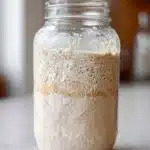Description
Master the art of sourdough baking from scratch by learning how to create a healthy, bubbly sourdough starter. This recipe guides you step-by-step through cultivating natural wild yeast, ensuring your breads have the signature tangy flavor and robust structure that only sourdough can provide.
Ingredients
Units
Scale
For the Sourdough Starter
- 1 cup (120g) unbleached all-purpose flour (plus more as needed for feedings)
- 1/2 cup (120ml) filtered or spring water (plus more as needed for feedings)
For Ongoing Feedings
- 1/2 cup (60g) unbleached all-purpose flour
- 1/4 cup (60ml) filtered or spring water
Instructions
- Mix Initial Ingredients: In a clean glass jar or container, combine 1 cup (120g) of unbleached all-purpose flour with 1/2 cup (120ml) of filtered or spring water. Stir until you have a thick, sticky dough with no dry flour streaks. Loosely cover the jar with a lid or plastic wrap and let it sit at room temperature for 24 hours.
- First Feeding: After 24 hours, you may see a few bubbles forming. Discard half of the starter (about 1/2 cup), and feed the remaining starter with 1/2 cup (60g) of flour and 1/4 cup (60ml) of water. Stir well. Cover loosely and allow it to rest at room temperature for another 24 hours.
- Continue Daily Feedings: Repeat the feeding process every 24 hours: discard half of the starter, then add 1/2 cup flour and 1/4 cup water. Mix thoroughly after each feeding, and keep the container loosely covered.
- Look for Activity: By day 3 or 4, your starter should show more bubbles, a yeasty aroma, and begin to rise and fall. Continue daily feedings and keep it in a warm spot (70-75°F/21-24°C if possible).
- Starter is Ready: Around day 5-7, your starter should double in size within 4–6 hours after feeding and have a pleasantly tangy smell. At this point, it’s active and ready to use in your favorite sourdough bread recipes.
- Maintenance: If not baking daily, store the starter in the refrigerator and feed it once a week. Always bring to room temperature and feed before using in recipes.
Notes
- Use unbleached all-purpose flour for more consistent results, though whole wheat flour can help jumpstart fermentation.
- Always use filtered or spring water; chlorine in tap water can discourage wild yeast growth.
- If the starter develops any pink, red, or orange spots or an unpleasant smell, discard and restart.
- Storage containers should be clean but not airtight, as the yeast needs to breathe.
- The starter may take longer to develop in cooler temperatures; be patient and keep feeding daily.
Nutrition
- Serving Size: 1 tablespoon (15g)
- Calories: 25
- Sugar: 0g
- Sodium: 0mg
- Fat: 0g
- Saturated Fat: 0g
- Unsaturated Fat: 0g
- Trans Fat: 0g
- Carbohydrates: 6g
- Fiber: 0g
- Protein: 1g
- Cholesterol: 0mg

